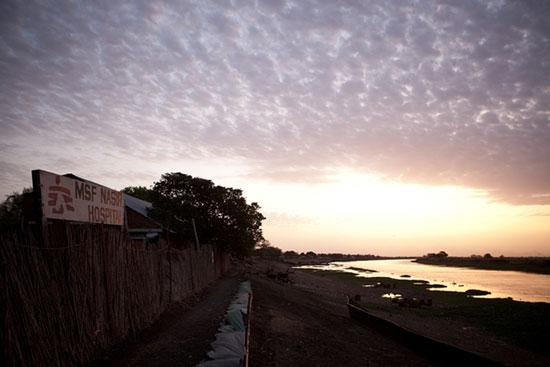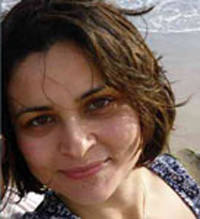MSF nurse Emma Pedley describes her hectic nights on call at an MSF project in Nasir, South Sudan.

South Sudan 2012 © Brendan Bannon
The MSF hospital and the Sobat river at dawn as seen from the river's edge in Nasir
Emma Pedley is a British nurse working on community outreach projects with Doctors Without Borders/Médecins Sans Frontières (MSF) in Nasir, South Sudan. Read her MSF Field Blog here.
It’s hard to give an idea of the bewildering breadth of patients that we are presented with during on calls. Even used as I am to the variety of humanity that compiles the average emergency department back at home, I am still frequently taken aback with the range of problems that the radio calls that I receive during the night require me to somehow deal with. The only part of the hospital that I don’t cover during the night is maternity, so the scope of cases I am called for range from ER cases that need admission to malnourished children in the inpatient therapeutic feeding center ( ITFC) who can deteriorate with frightening suddenness during the night to unstable patients in the ICU. . . .
“Expect the unexpected” seems to be the watchword of taking over the radio responsibility. Owing to both the language barrier and variable training level of the staff that are on duty at any one time, it can be very hard to tell from the radio call exactly how severe a patient you are called to see is. Especially “convulsions”—a term that seems to be a firm favorite with the staff here—which can cover anything from a true epileptic fit to someone writhing in pain to a bout of hysterics to the profound rigors and shivering that people experience when in the grips of a high fever. And occasionally we are just called over to deal with a stubborn patient who just wants to talk to the kawaja (foreigner) and won’t accept the instruction of the national staff. The best policy I have for dealing with calls is ask for as much information over the radio as possible while simultaneously making my way over the hospital as rapidly as I can—at 3:00 AM over the rough ground in torch light a brisk trot is about all I can achieve!
What follows are just a few of the more memorable cases of the sort I have experienced during my on calls in the last couple of months—they didn’t all occur during the same night, thankfully!
8:00 PM
“On call for ER—Emma on call for ER—we are very busy, please come?” I push my half-eaten dinner away and head over. When I get to the ER I regard the collection of people outside and sigh. With the OPD now across town at the Ministry of Health we are still getting a lot of non-urgent patients turning up at the MSF ER. Placating the harassed-looking ER staff member inside, I leave them seeing a forlorn-looking child with malaria while I go and fish a nurse out of the ICU to help. They act as my translator as I move through the crowd triaging and assessing severity. Three out of four people are told politely but firmly to go home and go to the OPD the next day. Within 30 minutes the crowd has dissipated and a sick-looking man and a couple of babies are left to be more thoroughly assessed and treated. No worries. Much better.
I’m about to go back to my congealing dinner when another couple of figures emerge out of the darkness, a mother with a small girl in tow. Neither exactly looks sick on first glance. I can’t help but growl internally. It would be so much better for everyone if people didn’t come to the hospital so late in the evening when they’ve been sick for a few days already . . . and I turn to the nurse to help me translate. When I look back at the three-year-old, though, I relent. She has diarrhea and it turns out that these two have walked for over two hours to come here; the child looks exhausted. I do a mental inventory of the wards and decide pediatrics can squeeze them in. Along with the oral rehydration an IV overnight won’t hurt. I can review and discharge the child before handing over in the morning.
9:00 PM
“Hello . . . hello, on call? This is pediatric ward . . .” I’m already sat in the ICU scribbling some notes when this call comes, so I amble across the walkway into the children’s ward. A seven-year-old boy is . . . well, not right. Vague history of abdominal pain, no appetite, has been in for four days now, looks a bit more peaky tonight. Treatment for amebiasis doesn’t appear to have helped. The boy is curled up on the bed. He doesn’t object as I gently reposition him and palpate his belly, but I notice his skin is covered with a faint sheen of sweat, and he curls up again as soon as I finish. No vomiting. Vital signs normal other than a very mild fever. I’m totally perplexed. Nothing I can put my finger on is wrong, but internally all my cumulative nursing experience is screaming at me that this child is a lot sicker than he looks. I move the child to ICU for closer observation during the night and hesitantly call the surgeon for a second opinion. The subsequent day the boy is diagnosed with typhoid fever and bowel perforation and undergoes extensive surgery. Typhoid fever masks the usual fast heart rate of a septic patient with paradoxical slowing of the pulse, making it appear normal. Thank god for following my instincts.
10:00 PM
“On call for ICU—we need one IV cannula . . .” This is my second ever night on call, first ever solo radio call for ICU. An IV cannula, how hard can that be? Bread and butter of my days at home, I muse as I wander over to the hospital. Except at home I was never required to put in an IV cannula on a three-day-old baby in respiratory distress. The old cannula has stopped working—taking out the baby’s left hand as a possibility—and leaving me with two fragile, thready veins on the back of the right hand to get a line into. Up to this point the youngest person that I have done this on is a teenager. I gather all my equipment, ask a nurse to act as a tourniquet, and stare unhappily in the torchlight at the tiny, almost translucent hand now held in my own.
My first attempt is not successful—the baby squawks in protest at the restraint of being held so tightly by his mother, who I notice now is looking at me with an expression of complete trust and confidence. More confidence than I have. I debate calling the doctor . . . but I’m not going to get away from the fact that I will have to do this one day without backup. Now is as good a time as any. I grit my teeth and try again in the second vein at an infinitesimally different angle to the first time and—miracle—a tiny flash of red in the cannula’s viewing chamber. I’m almost too taken aback to carry on, but happily the ICU nurse isn’t and between us we secure the line in place and restart the child’s IV fluids.
I look up from my cramped position squatting on the floor by the bed and grin at the nurse—he grins back and we do a little high five in front of the uncomprehending mother, who clearly never doubted the kawaja’s abilities.
11:30 PM
“Hello, on call for ITFC?” Oh bugger, I’ve been dreading being called there. Infants are not my forte. I’m snatching a quick shower when this call comes and hurriedly towel off and pull clothes onto my still-damp body. I cautiously walk into the semi-dark ward which, full as it is of babies, is never entirely quiet. There are soft sleepy cries from the beds on both sides of me as I walk towards the pool of torchlight that indicates where the staff member is crouched by a patient.
A teeny tiny naked baby is laid next to his mother waving all four stick-thin limbs in the air. One of week-old premature twins. Hypothermic. Sweating as I am in the 30 degree evening it’s hard to believe that hypothermia is possible here, but there you go—babies’ internal body thermostats take a few months to kick in. The baby is only 32 degrees—urgh, that really is low.
We scramble about for one of the silvery reflective survival blankets to wrap him in, but it turns out that one is torn and the other is on a child in the ICU. And it’s not like we have an incubator we can pop him into. I pause—and then remember something from my tropical nursing course. With the night staff we persuade mum to disrobe her top half and lay flat on her back. Her tiny mewling son is laid naked on her chest and we bundle blankets around them both. Kangaroo care. Back to basics. Skin to skin. The baby’s temperature comes up within an hour. Magic.
1:00 AM
“On call for adult ward . . . yes , we have one severe patient . . . please come.” I roll out from under the mosquito net fully dressed, grab a torch, and yawningly exit my tukul. Once in the adult ward I am led to a bed in a dark corner where a semi-conscious old man is laying, his breathing harsh and erratic. His diminutive grey-haired wife is huddled on a corner of the bed. This does not look good. I put my stethoscope into my ears and bend down to listen to the chest—crackles and bubbling galore—and leaf hurriedly through the notes when they are brought to me, squinting at the clinical officer’s spidery handwriting interspersed with the doctor’s scrawl. Probable heart failure. Blood pressure too low for a diuretic during the day, lungs too wet to give fluids to treat the blood pressure now. This is the extent of the treatment we can offer here.
This man is dying. But we can make him comfortable at least. A smidge of IV opiate later and the labored breathing eases. I kneel by the wife and explain with the translation of the nurse that there is nothing else we can do, but we can relieve his distress. Her milky cataracted eyes look at me and she nods. No denial, no debate—death here is a part of life. I hope she has some family who can look after her when he’s gone. Later in the night I check back—the man is still breathing but slower now. His wife keeps her vigil at the foot of his bed. At 6:00 AM I’m called again—the breathing has stopped. His still body is resting now, in counterpart to his wife who is rocking back and forth chanting softly. Across from the hospital compound a riotous singing has started up at the early morning church service and I feel a burst of indignation at the seeming inappropriate contrast between the sound of the cheerful hymn and the tragic tableau in front of me. The widow has to go and get some family to help her carry the body home and she shuffles out of the hospital gates into the lightening dawn.
My indignation fades with the retreating night and I watch dawn spread across the sky. She has family. He died peacefully, cared for, with his wife by his side and music in his ears. There are worse things in this world.
2:00 AM
“Oncall, oncall for ICU—we have one child, yes, there are convulsions . . .” I jolt into wakefulness and am out of my bed and running over to the hospital as fast as I can go, telling the nurses to prepare IV diazepam down the radio as I go. This could be anything, but always think worst case scenario . . . I arrive on the ward and yes, this is actual convulsions, a four-year-old with cerebral malaria. IV diazepam, prone position to prevent vomiting, rectal paracetamol, cold bathing, check blood glucose, give fluids . . . the fit slows and stops. The child is stable for now. Not sure I’m going to be able to get back to sleep though . . .
3:00 AM
“Hello oncall for ER . . . Hello? . . . HELLO ONCALL?” I fumble for the radio handset in the darkness and belatedly croak a response into it. A scorpion bite in the ER, I’m informed. Ooh, interesting—although I’ve read about them I haven’t seen one of these before. The nights are hotter now and I pull my t-shirt on, stoop out of my tukul, and drag my sweat-damp hair into a ponytail as I walk across the compound.
I can hear a whimpering that gets louder as I approach the ER. As I step into the well-lit room I am simultaneously aware of two things. One: my MSF t-shirt is back to front and inside out—whoops, hardly professional—and two: this woman is in agony.
The people of this place have what appears to me a sky-high pain tolerance—postoperative children who would be bed bound on morphine drips at home are sat up looking cheerful within 24 hours, women cruise daily through labor and delivery with no analgesic assistance, men unflinchingly watch you poke their rhino-hide skin with needles as you search for veins. The elderly woman in front of me is sat on the concrete floor whimpering and clutching at her ankle, rocking rhythmically, her face twisted with pain. This is no sham. She was stung whilst walking out of her tukul to the toilet. Her sons who have carried her for an hour to get here flop exhausted against the wall and expectantly regard the disheveled apparition of a kawaja that has just walked in. I put them to work again carrying her to an examination couch and unlock the cupboard where the local anesthetic lives.
As hideously unexpected and unpleasant as the scorpions here are, they are not lethal—just excruciating. I draw up a syringe of anesthetic and the nurse helps me to clean and prepare the woman’s foot for the injection. Her crying crescendos every time we touch her leg and she buries her face in her shawl wailing as I approach her foot with the needle. Her skin is tough and calloused but I persist and squeeze in a few milliliters of lignocaine around the minute puncture site that is the source of all her distress.
Within seconds the crying stops—literally, it is that fast—and she looks up incredulously at the blessed numb relief. We all—including her sons—start laughing at her expression of evident surprise. Ten minutes later she is smiling and ready to go home. Her sons shake my hand as they file out and she clasps both my hands and croons delightedly at me in Nuer before walking erectly away—this woman who couldn’t stand when she arrived. I grin. Who cares which way round my t-shirt is?
And finally, from this week at 5:30 AM
“Hello oncall, this is surgical ward—we need some paracetamol.” I bury my head in my pillow and stifle a groan. Why, oh why, couldn’t they have foreseen the lack of paracetamol when they came on duty last night? I shamble over to the ward, rubbing my eyes, there’ll be no point going back to bed after this. I grumblingly examine the chart—yes, the patient is due paracetamol, jolly good, I’ll go and get it. I discontentedly wander around the hospital after I’ve solved the drug shortage. Pediatric ward are preparing their IV medications. ITFC is a cacophony of noise as children are awoken for their early morning milk feed. The ICU patients are thankfully stable. A pregnant woman with severe pneumonia who was struggling to breathe last night is finally sleeping. Humph. Lucky her.
En route back to the expat house I meet Ruth, our American midwife, who if possible looks tireder than I feel, having been up delivering not one but three babies overnight. We both have busy days ahead of us, her in the antenatal clinic, me supervising the IPD. We sit down to share a coffee and brief moan as day breaks and wonder aloud why we have chosen such a demanding job with such antisocial hours. Is it really worth it? Really??
I think back over the patients I have seen on my last few on calls. The boy with typhoid fever. The scorpion bite. The hypothermic baby. Even the man who died. I’ve made many people more comfortable; some in their last moments, some in their first few days of life, and maybe even helped save one or two lives. A contentment spreads through me that no amount of tiredness can steal away.
Is it worth it?
Oh, yes. Every single sleep-deprived second.





